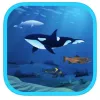Take a look inside 5 images
iBiome -- Ocean
Pros: Impressive amounts of content, interactive tasks, and a digital journal help students explore feeding relationships.
Cons: Scant guidance when kids experiment, along with some feedback that scrolls too fast, could lead to confusion or hollow exploration.
Bottom Line: With some extra scaffolding, this interactive resource can be a unique way to reinforce concepts related to ocean ecosystems.
Use iBiome – Ocean to reinforce concepts that students learn during a unit about ecosystems. Students can complete tasks within a selected habitat either individually or in pairs. As kids work, have them take notes about their food webs and the feeding relationships they observe. After completing all tasks in the habitat, discuss as a class what kids learned and work together to recreate the food web using a large sheet of butcher paper (or create a digital version of the food web).
In iBiome – Ocean, Professor Bio begins by introducing kids to some general information about the importance of oceans and the organisms that live there. For the main activity, students can explore four ocean habitats: open sea, coral reef, tide pool, and kelp bed. Within each habitat, students complete tasks to build food webs in a "biodome." For example, students identify consumers, producers, and environmental factors. Then they drag and drop these organisms into the correct places to form a food web. Once kids complete a task, a new species is unlocked. The species gets placed in a virtual journal, where kids can tap to learn more about all the species that they've unlocked.
Students are given the opportunity to experiment with their biodomes by adding species to see how the habitat is affected, and they earn badges for some of these accomplishments. There's also a Build feature that lets kids tap icons to construct different technologies, but its purpose is unclear.
iBiome – Ocean is packed with information and engages kids with interactive tasks. The journal is an excellent resource of images and descriptions of organisms, and the food webs are fantastic visual models of feeding relationships. As they build their biodomes, students learn about producers, consumers, and predator/prey relationships. But they'll need to work quickly because the tasks are timed, and kids don't earn stars if they take too long. It would be nice to be able to turn the timer off for students who need to spend more time on the tasks and don't want the distraction of a timer.
If students drag organisms into the wrong place within a food web, they get some useful feedback. However, if they incorrectly place more than one organism, the feedback scrolls way too fast for kids to read all of it; a pop-up window that lets students close out the feedback when they're ready might be a good solution. Experimenting within the biodomes can be confusing, as is the Build feature, so adding some more instructions and follow-up explanations could help. Overall, iBiome – Ocean is a unique and interactive way to learn about aquatic habitats.














